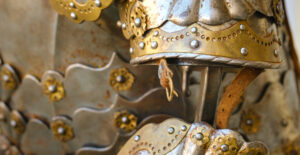
In the flicker of taxi brake lights and the hum of Johannesburg’s late-night street hustle, a quiet resurgence is glinting beneath collarbones and disappearing into shirt cuffs. It isn’t just fashion. It’s faith, fear, and sometimes desperation, melted into the form of gold amulets.These are not the gaudy status symbols of rappers and Sandton’s high-rise elite. These pieces don’t scream for attention, they whisper old prayers. Across South Africa’s cities, especially in corners where prosperity is a myth and risk is currency, gold has taken on a strange new weight. Not as an investment, not even as inheritance, but as a shield. A talisman. A deal with something older than money.
Amid the taxi ranks of Berea and the alley markets of Durban, spiritual jewellers operate in a currency of superstition and survival. Their customers don’t want logos. They want protection from curses, car accidents, street violence, and spiritual attack. Some wear a gold-plated khamsa tucked beneath their uniform shirts. Others carry tiny lion-head pendants, believed to channel strength in moments of confrontation. A few prefer nothing visible at all, just thin chains dipped in holy oil and worn under layers of clothing like silent alarms.
There’s no catalog for this kind of gold. No website with filters by karat. You find it through whispered referrals. A cousin of a cousin. A stall in the back of a hair salon. A tiny shop with incense smoke curling above a locked case. Some say it’s not the gold that protects, it’s the ritual done over it. The ancestral blessings. The Quranic verses. The water from the river they won’t name.
Gold has always had spiritual weight. Pharaohs were buried with it. Preachers hold it up to symbolise divine blessing. In South Africa, where colonial exploitation stripped the land of gold and the people of power, the return of gold as a tool of protection feels poetic. A reclaiming of what was once extracted. A way to turn survival into ritual.
But this isn’t some quaint revival of tradition. This is urban alchemy. This is gold forged in a world of load shedding, unemployment, TikTok tarot readers, and rising crime. In Soweto, a young sangoma says her clients don’t just want spiritual guidance anymore, they want insurance. They come to her with gold earrings from their grandmothers, asking if she can “bless” them into amulets. She melts them down and recasts them in shapes based on visions or dreams. A circle for continuity. A horn for protection. A heart with a dagger through it for revenge.
“Not everyone can afford to buy security,” she says. “So they wear it.”
In a nation where many still live on borrowed luck and bullet-prayers, the line between faith and fashion has blurred. On Instagram, some users post their gold amulets with vague captions, “Protected.” “Cleansed.” “Hidden in plain sight.” Hashtags mix spirituality with street culture, #BlessedAndBulletproof, #GoldWithPurpose, #ChainsThatGuard.
Of course, the commodification of belief raises questions. For every authentic spiritual jeweller working out of a township or a cultural center, there’s a charlatan charging exorbitant prices for mass-produced trinkets dipped in prayer and wrapped in mystery. Scams are common. There are reports of fake gold being sold with “blessings” attached, sometimes leaving buyers not only spiritually disappointed, but financially devastated.
Still, the underground spiritual gold trade thrives, because in many urban corners, belief is the last economy that hasn’t collapsed.
 And there’s a gendered layer to it, too. Young women, especially, are driving this resurgence. In a country where femicide statistics feel like national shame, more women are turning to protective charms, sometimes in addition to pepper spray and location-sharing apps. One University of Pretoria student wears a tiny gold ring, blessed by a traditional healer, that she calls her “invisible shield.” Whether it works or not is irrelevant, she says. “It makes me walk like I’m not alone.”
And there’s a gendered layer to it, too. Young women, especially, are driving this resurgence. In a country where femicide statistics feel like national shame, more women are turning to protective charms, sometimes in addition to pepper spray and location-sharing apps. One University of Pretoria student wears a tiny gold ring, blessed by a traditional healer, that she calls her “invisible shield.” Whether it works or not is irrelevant, she says. “It makes me walk like I’m not alone.”
Even men, who often shy away from overt displays of spiritual vulnerability, are turning to these talismans. Some ask for pieces carved with the names of deceased uncles or grandmothers. Others opt for zodiac-based symbols, worn beneath soccer jerseys or business suits.
The irony, of course, is that in a country whose economy was once built on gold, it’s the spiritually poor who are now using it not for wealth, but for warding off ruin. While mining conglomerates report profits in boardrooms, a boy in Khayelitsha wears a tiny gold lion around his neck and believes it’ll keep the gang recruiters away.
Gold has always been loaded, with power, danger, lust, and myth. But this chapter of its story is different. It’s not about gold as destination, but gold as defense. Not about flash, but about function. It’s a return to gold as a medium of meaning, a wearable contract between the wearer and the world, between fear and faith.
In the shadows of broken streetlights and the margins of the formal economy, spiritual gold amulets have become part of South Africa’s new vocabulary of survival. They’re not on display in store windows. You won’t see them featured in fashion editorials. But they exist, quietly, stubbornly, around wrists, over hearts, under clothes.
Gold, in its purest form, does not tarnish. Neither do the hopes it carries.
And in this strange new age, where belief costs money, protection feels personal, and power is rarely official, maybe that’s the only kind of currency that still means something.



